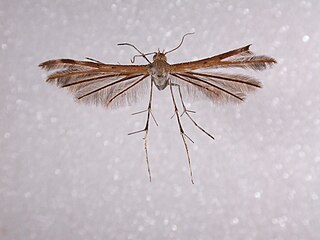
Megalorhipida leucodactyla is a species of moth of the family Pterophoridae that has a pantropical distribution.

Lantanophaga pusillidactyla, the lantana plume moth, is a moth of the family Pterophoridae. It is native to the southern United States, Mexico, the Caribbean, and South America. It was introduced to Australia accidentally in 1936 and is now found from Sydney to Cairns along the coast. It has also been introduced to Hawaii in 1902, Pohnpei in 1948, and Palau in 1960 for biological control. It has since been recorded from Yap in 1987–1988 and is now distributed on all islands of the Mariana and Caroline Islands where the host plant is found, except Aguijan.

Exelastis pumilio is a moth of the family Pterophoridae. It has worldwide tropical distribution, including Argentina, Brazil, Colombia, Costa Rica, Cuba, Ecuador, Guadeloupe, Jamaica, Mexico, Puerto Rico, Suriname, Japan, Micronesia, South Africa the Virgin Islands as well as Queensland and New Guinea.

Pterophorus albidus is a moth of the family Pterophoridae. It is distributed in Africa, south and south-east Asia, including New Guinea and Australia, as well as Japan (Kyushu) and the Ryukyu Islands.
Tomotilus celebratus is a moth of the family Pterophoridae. It has been reported from Australia, India, Japan and Indonesia (Java). Until recently the species was known as Tomotilus saitoi, but the earlier name Oxyptilus celebratus has been recognised as an earlier reference to this same species.

Anatrachyntis rileyi, the pink cornworm, pink bud moth or pink scavenger, is a species of moth of the family Cosmopterigidae, the cosmet moths. It was first described by Lord Walsingham in 1882 from the southern United States, but it is probably an introduction to North America. It is found in much of the warm or tropical areas of the world, including northern Australia, the Galápagos Islands, Hawaii, the Antilles, South America and Mauritius.

Platyptilia farfarellus is a moth of the family Pterophoridae. The species was described by Philipp Christoph Zeller in 1867. It is found from central and southern Europe to Asia Minor, Micronesia and Japan. It is also known from Africa, where it has been recorded from Equatorial Guinea, Kenya, Madagascar, Mauritius, Nigeria, South Africa, São Tomé & Principe, Tanzania, Uganda, the Seychelles and Malawi.
Platyptilia vilema is a moth of the family Pterophoridae. It is known from the Galápagos Islands.
Bipunctiphorus nigroapicalis is a moth of the family Pterophoridae. It is known from the Galápagos Islands and Venezuela.
Lantanophaga minima is a moth of the family Pterophoridae. It is known from the Galápagos Islands.
Stenoptilodes gielisi is a moth of the family Pterophoridae that is known from the Galápagos Islands.
Postplatyptilia huigraica is a moth of the family Pterophoridae. It is known from Brazil, Colombia, Costa Rica, Ecuador, Peru and Venezuela.
Pterophorus leucadactylus is a moth of the family Pterophoridae. It is known from Sri Lanka, Sumba, New Guinea, India, China, Taiwan, Malaya, Sumatra, Java, Borneo, the Philippines, Micronesia, the Bismarck Islands, the Solomon Islands, Australia and Vietnam.

Hellinsia inquinatus is a moth of the family Pterophoridae. It is found in North America, including Florida, Mississippi, Oklahoma, Tennessee, Maryland, Alabama, Texas, Missouri, Colorado and Arizona. It has also been recorded from Hispaniola, Mexico, Puerto Rico and St. Thomas Island.

Oidaematophorus eupatorii, the eupatorium plume moth or Joe Pye plume moth, is a moth of the family Pterophoridae. It is found in North America, including Florida, Mississippi, Iowa, New York, California and Vancouver Island. It is also known from Mexico, Guatemala and Panama.

Hellinsia cristobalis is a moth of the family Pterophoridae. It is found on the Galapagos Islands.

Hellinsia devriesi is a moth of the family Pterophoridae. It is found on the Galapagos Islands and Guadeloupe.

Hellinsia argutus is a moth of the family Pterophoridae. It is found in Colombia, Ecuador and Peru.
Gillmeria melanoschista is a moth of the family Pterophoridae described by Thomas Bainbrigge Fletcher in 1940. It is found in Russia and Japan.

Adaina scalesiae is a moth of the family Pterophoridae that is endemic to the Galapagos Islands, where it was discovered by Bernard Landry on Bella Vista on April 1, 1992, and on May 25 of the same year on the island of Santa Cruz. The species was also found in Volcan Darwin, a province 15 kilometres (9.3 mi) from Puerto Villamil, on May 25, and 400 metres (1,300 ft) above sea level on Pinta Island where it was found from March 13 to 21. The species is attracted to various lamps including mercury-vapor lamps.












